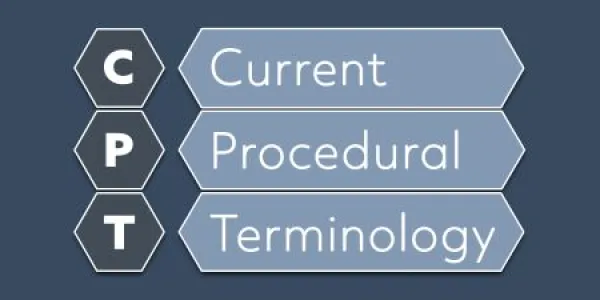Pain Management Coding Alert
New Block Code Set for CPT® 2025
Thoracic block? There’s a code for that next year.
CPT® has released its list of new, revised, and deleted codes for 2025; for pain management (PM) coders, it contains one new set of codes that will be extremely relevant.
The lowdown: CPT® is adding a code set specifically for thoracic fascial plane blocks — and you’ll certainly want to let everyone in the practice know about it.
Check out the changes you’ll want to note before CPT® 2025 takes effect on January 1, 2025.
Report These Codes for This Thoracic Block
CPT® 2025 will feature a new code set for thoracic fascial plane blocks. These regional blocks are used to control thoracic pain. During the block, the PM provider injects local anesthetic into fascial planes around the chest, blocking pain signals.

The new codes for thoracic fascial plane block are:
- 64466 (Thoracic fascial plane block, unilateral; by injection(s), including imaging guidance, when performed)
- 64467 (… by continuous infusion(s), including imaging guidance, when performed)
- 64468 (Thoracic fascial plane block, bilateral; by injection(s), including imaging guidance, when performed)
- 64469 (… by continuous infusion(s), including imaging guidance, when performed)
- 64473 (Lower extremity fascial plane block, unilateral; by injection(s), including imaging guidance, when performed)
- 64474 (… by continuous infusion(s), including imaging guidance, when performed)
Know This About Plane Blocks
There are a few elements to these blocks you should familiarize yourself with. First, a thoracic fascial plane block might also be referred to as TFPB, so be on the lookout for this acronym in the notes. A TFPB provides pain relief specifically targeted to the thoracic region. During a TFPB, the PM provider injects local anesthetic into specific fascial planes of the thoracic wall in order to treat specific nerves for pain.
Guidance on what types of ICD-10 codes will be acceptable to payers for TFPB hasn’t surfaced yet. However, there are a few scenarios where a patient might need a TFPB, including:
- Pain management after thoracic surgery
- Rib fractures
- Chronic pain issues in the thoracic region
- Chest wall trauma
Best bet: Check your payer’s policies on acceptable ICD-10 codes for the new TFPB codes. Since the codes are new, your payers very likely have not updated their policies to reflect the CPT 2025 additions. If you can’t find anything related to TFPB in your payer contract, contact a representative.
Check Out This Clinical Example
A new patient recovering from two broken ribs on the right side reports to the PM practice. During an office evaluation and management (E/M) service that includes low-level medical decision making (MDM), the provider decides that the patient could benefit from a TFPB. The PM provider places the patient in a sitting position. Using ultrasound (US) guidance, the provider visualizes the fascial plane and identifies the pleura, intercostal muscles, and thoracic fascia. Using US guidance to place the needle, the provider injects local anesthetic into the fascial plane between the internal and external intercostal muscles. They then recommend rest for the patient and send them home.
This is an instance of a TFPB by needle. When CPT® 2025 becomes effective, you would report the following:
- 64466 for the block
- Modifier RT (Right side) appended to 64466 to indicate laterality
- 99203 (Office or other outpatient visit for the evaluation and management of a new patient, which requires a medically appropriate history and/or examination and low level of medical decision making. When using total time on the date of the encounter for code selection, 30 minutes must be met or exceeded.) for the E/M service
- Modifier 25 (Significant, separately identifiable evaluation and management service by the same physician or other qualified health care professional on the same day of the procedure or other service) appended to 99203 to show that the E/M and the TFPB were significant, separately identifiable services.
Remember: Codes Are Resequenced
The new codes are out of sequence, so you won’t find them in the proper numerical location in CPT® 2025. They are additions to another group of resequenced codes, which start after +64484 (Injection(s), anesthetic agent(s) and/or steroid; transforaminal epidural, with imaging guidance (fluoroscopy or CT), lumbar or sacral, each additional level (List separately in addition to code for primary procedure)) and end before 64486 (Transversus abdominis plane (TAP) block (abdominal plane block, rectus sheath block) unilateral; by injection(s) (includes imaging guidance, when performed)).
Between those codes, the 2025 CPT® book will list these resequenced codes:
- # Denotes resequenced code
 Denotes new code
Denotes new code- # 64461 (Paravertebral block (PVB) (paraspinous block), thoracic; single injection site (includes imaging guidance, when performed))
- # +64462 (… second and any additional injection site(s) (includes imaging guidance, when performed) (List separately in addition to code for primary procedure))
- # 64463 (… continuous infusion by catheter (includes imaging guidance, when performed))
 64466
64466 64467
64467 64468
64468 64469
64469 64473
64473 64474.
64474.
Chris Boucher, MS, CPC, Senior Development Editor, AAPC

